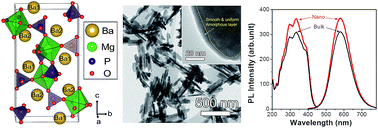Wet-chemical preparation of barium magnesium orthophosphate, Ba2Mg(PO4)2:Eu2+, nanorod phosphor with enhanced optical and photoluminescence properties†
Abstract
We report a wet-chemical synthesis of yellow-emitting nanorod phosphors based on a Eu2+-doped Ba2Mg(PO4)2 (BMP:Eu) orthophosphate compound, and its enhanced optical and photoluminescence properties. A phase-pure BMP:Eu nanorod phosphor was prepared, for the first time, by using a two-step procedure: preparation of an amorphous nanorod precursor by a solution method (pH and reaction-temperature control) and a subsequent post-annealing process. The BMP:Eu phosphor prepared under optimal conditions (5.0 mol% of Eu2+, reacted at a pH 9, and annealed at 800 °C in a reducing atmosphere) consisted of ∼350 nm (length) × ∼60 nm (diameter) nanorods. This phosphor exhibited superior photoluminescence and optical properties compared to a micro-sized bulk BMP:Eu phosphor that was prepared by using a conventional solid-state reaction method: the nanophosphor, exhibited a higher light absorption in the n-UV region and higher transmittance of longer-wavelength light (yellow, ∼600 nm), owing to its smaller/uniform size, nanorod morphology, and high dispersivity in epoxy. The nanophosphor is therefore well-suited for white-LED applications.



 Please wait while we load your content...
Please wait while we load your content...